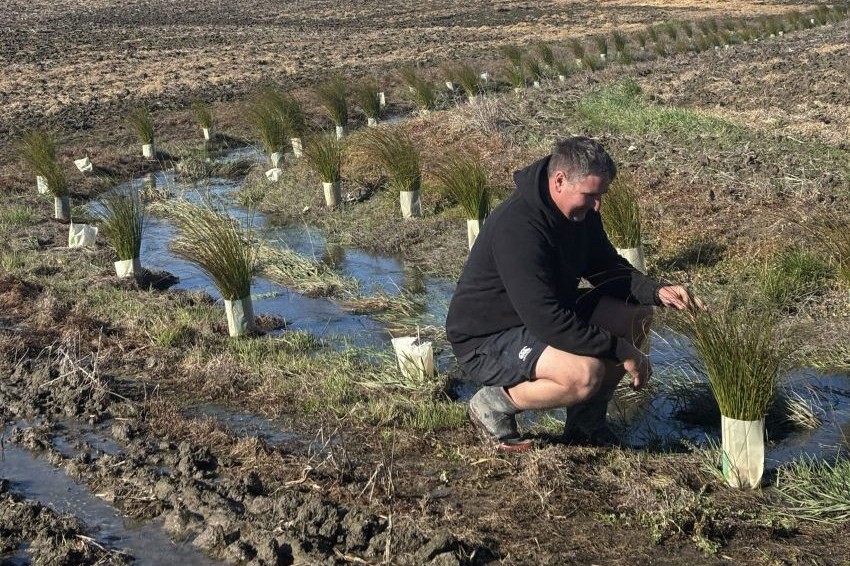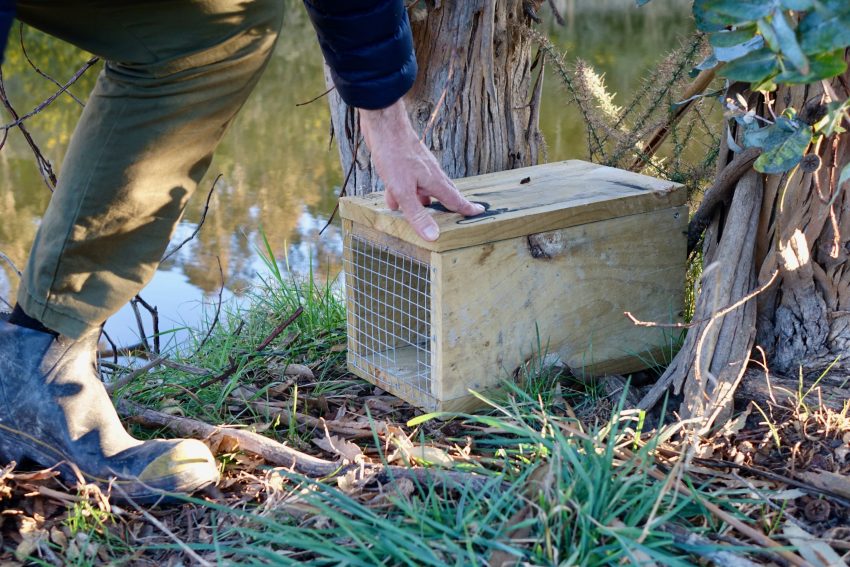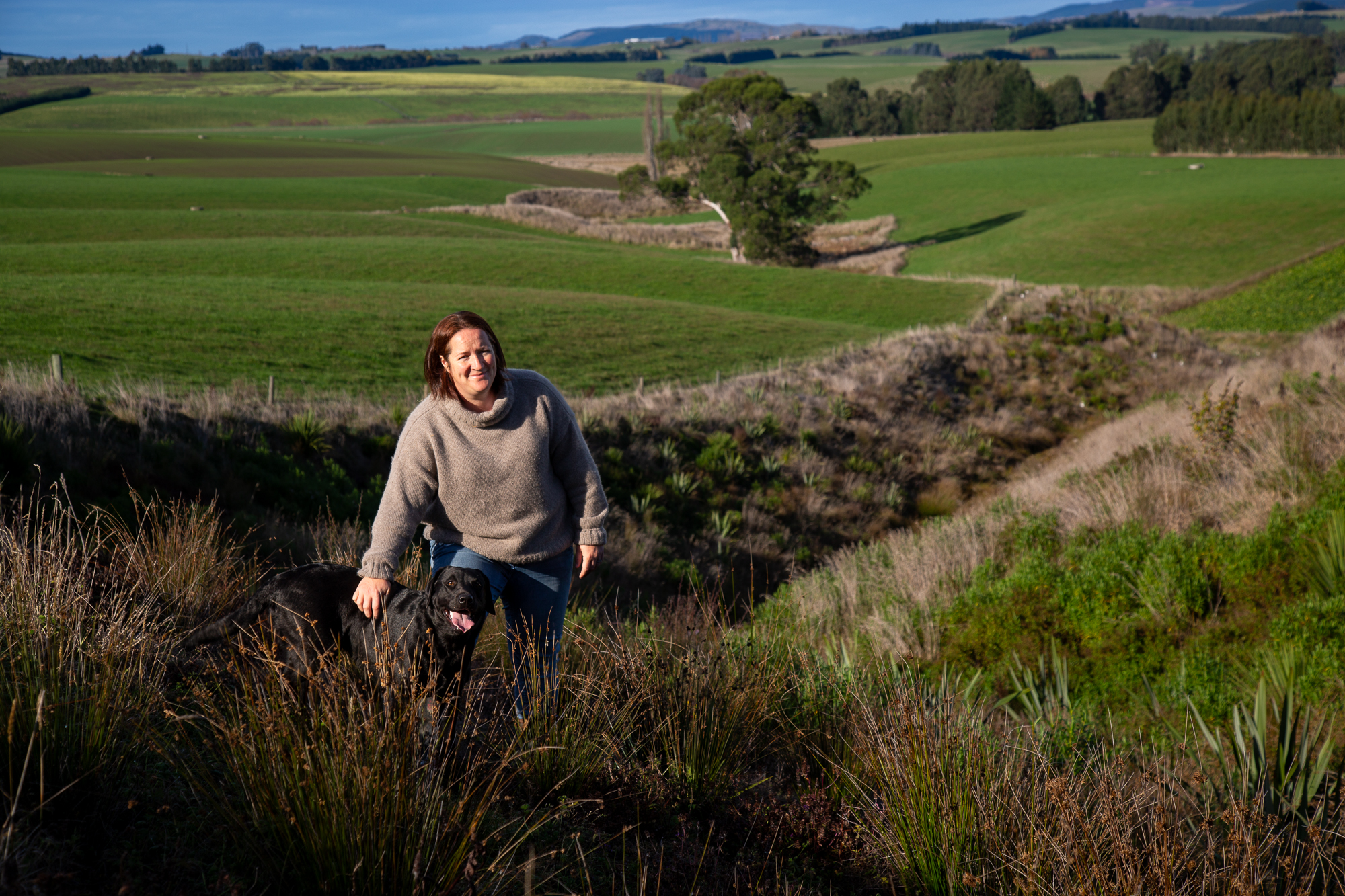The case for genetic modification
New Zealanders were scared off GM back in the early 2000s, but the science has moved on since then and the calls to rethink our stand on gene-editing technology are getting louder. By Joanna Grigg.
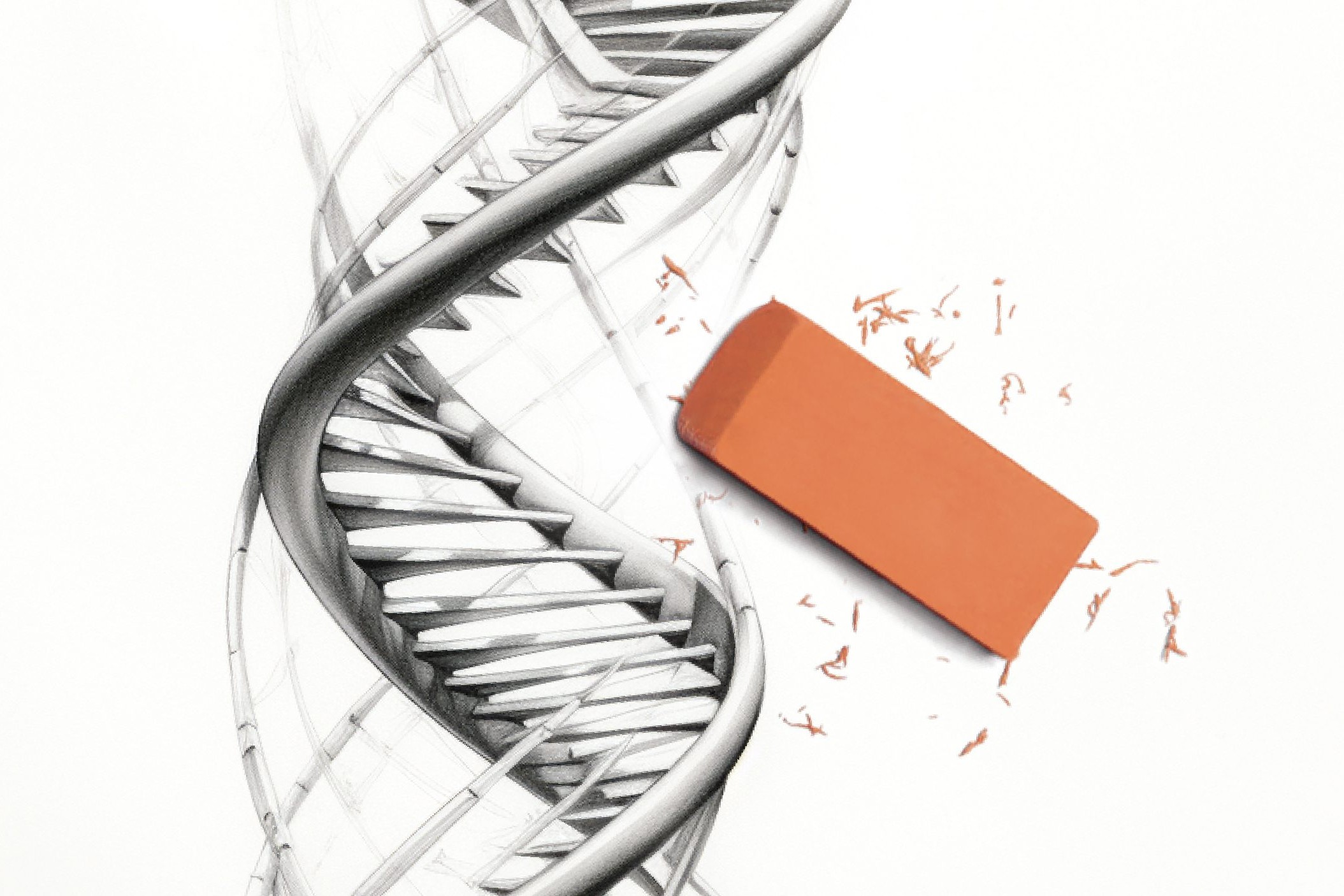
Modern tools to shape plant and animal genetics have been largely off the menu for New Zealand-based scientists. The gate to onfarm trials has been firmly closed.
Transgenesis – also called genetic engineering or modification (GM) – didn’t sell well to the NZ public initially. The 2002 memory lingers on saboteurs raiding a GM potato trial at Crop and Food Research near Christchurch.
Time has seen science move on. Plant genes can now be edited in different, more accurate ways, and also with or without bringing in genes from another plant or animal. Gene-editing technology involves deleting genes, inserting them, or switching them on and off.
Plant scientist and CEO of Grasslanz Technology John Caradus said it was time to revisit regulations and have an educated debate. When the Hazardous Substances and New Organisms Act 1996 was brought into law, gene-editing was not developed. “Our current regulations are no longer fit for purpose.”
He said research on GM was still funded by the NZ Government but the products can’t get past the gate-keeper. Policy means NZ is poorly equipped to make a strategic decision on the release of GM organisms to the outdoors.
National took a political first step in June – perhaps prompted by advocacy. They are proposing to update rules and open up access to gene editing and genetic modification. Labour has also hinted at a willingness to revisit it.
As many Kiwis have been wandering in the GE-free desert, far from the world of this biotech science, it will be tough to catch up.
As yet, there are few “go-to” voices among ag leaders who have emerged in this space.
John Caradus describes himself as an “plant-breeder of old” and an introvert by nature. He is now, perhaps reluctantly at times, on the speaking circuit helping agriculture (and beyond) get up to speed.
“I’ve watched for 25 years at the lack of engagement of politicians and some agriculture leaders on this issue – we need leadership here.”
He spoke at a plant breeders conference in July about NZ being “increasingly out of step”.
“Why allow plants into NZ that have been radiated to form a mutation – which is so random – but not allow targeted gene removal in a plant, which is precise.”
“It’s plain nuts. We need open debate involving industry and political leaders about benefits and risks.”
Caradus works for an organisation that invests in forages and microbes that are developed using transgenics. That conflict aside, he knows how it all works and has the gift to be able to explain it.
His recent papers include whether consumer attitudes would reduce the demand and acceptance of food produced by NZ pastoral farmers if GM forages were included in animal feed.
He has also written about different plant breeding techniques and the perceptions people hold – covering from 10,000 years since the domestication of maize through to modern breeding using tools such as gene editing.
It can be heavy going, but Caradus says this stuff should be in plant breeding 101 for farmers.
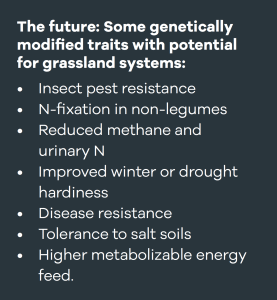
Tools available
The take-home message with modern breeding is that there is a huge range of tools. One that farmers might know is using chemicals to double a chromosome in perennial ryegrass. Bingo – there’s a tetraploid ryegrass.
Bomb something with radiation and you get a mutation.
Some of these mutation-induced cultivars in the lab have gone on to be popular. The highest number are used in Asia (with 2087 cultivars – mainly rice), followed by Europe (960), down to Australia/Pacific (9).
Another tool – and getting more techy here – is reverse genetics and breeding. It’s all about deleting what you don’t want out of the sequence. Options are using a virus to silence the gene (VIGs) or RNAi, which suppresses expression of the gene.
Another tool is mixing genes from different organisms. Transgenesis involves introducing genes from other organisms to another. It may also involve genes artificially synthesised in the laboratory. Cisgenesis is defined as transferring a gene from the same or a closely related species. This is a method that is defined as GM in NZ, but not in other countries.
Gene-editing is the most precise tool of them all, at this stage. There are lots of different ways to do it, but the most familiar term is probably CRISPR.
CRISPR gene-editing uses site-directed nucleases (SDN) which uses different enzymes to cut the DNA at a set spot.
AgResearch used a gene-editing technique called TALENS to produce edited cattle with milk that is hypoallergenic. Modified embryos were placed in surrogate cows resulting in calves born (in containment). This research work is not ongoing.
Caradus said that each breeding result must be weighed up on its merits; not just ban the whole tool box.
There would have to be a convincing cost-benefit analysis for each product and the onus is on science to deliver this, he said.
He would like objectors to stick to the facts.
“GE Free NZ and Sustainable NZ are against some of the biotechnologies, but we need them to back up their statements with facts.”
When it comes to GM food products consumed in NZ, there are about 90 on the list, Caradus said.
“Farmers can eat these plants and seeds but not grow them, so the issue for us is the effects of them growing in our environment.”
When queried whether GM sits with brands like regenerative or organic, Caradus said the organic market has indicated a “no”. He said the regenerative agriculture term is loosely defined and alignment with GM concepts largely untested.
 “Organics turning their back on gene editing may be unfortunate, as you can measure risk with each application, and you are switching a gene on and off, and this could happen naturally too – we just make it happen.”
“Organics turning their back on gene editing may be unfortunate, as you can measure risk with each application, and you are switching a gene on and off, and this could happen naturally too – we just make it happen.”
He said the potential to help the environment and reduce chemicals could be a great fit with organics.
Where he does see debate ahead is around whether organic farmers can co-exist alongside gene-edited neighbours. Pollen, for example, doesn’t respect boundaries.
His list of risks to be debated are testing for human and animal health and welfare (e.g. allergies), the impact on beneficial non-target organisms (e.g. insects) and understanding gene flows from GM crops.
Professor Andrew Allan from the School of Biological Sciences at the University of Auckland said NZ policy was made law before the development of new techniques. It made the application of the law vague and not based on biology or science.
He saw real disadvantages in the status quo – especially around climate change.
“Our existing crops are under threat and traditional breeding methods can’t keep up with warming temperatures.”
Allan said there should be a “case-by-case decision tree as to whether an edited organism provides a measurable benefit, without an increased risk”. This would be compared to an established breeding practice.
When it comes to market perceptions, he said overseas markets could continue to receive NZ products labelled GMO-free and new products labelled appropriate to that product.
“Having an edited crop in New Zealand does not taint all New Zealand products.”
A 2022 survey in NZ (Research First, 2022) showed that 32% of surveyed people supported gene editing in food production, 47% were neutral and 21% were against. When it came to pasture quality traits, 62% of NZers supported gene editing for this, while 15% were against.
Caradus studied whether the use of GM plants in NZ for food production would have long-term deleterious effects in overseas markets. He concluded that the evidence showed it wouldn’t, although there would always be a proportion of consumers against the use of GM in food production.
More digestible lucerne on the US market
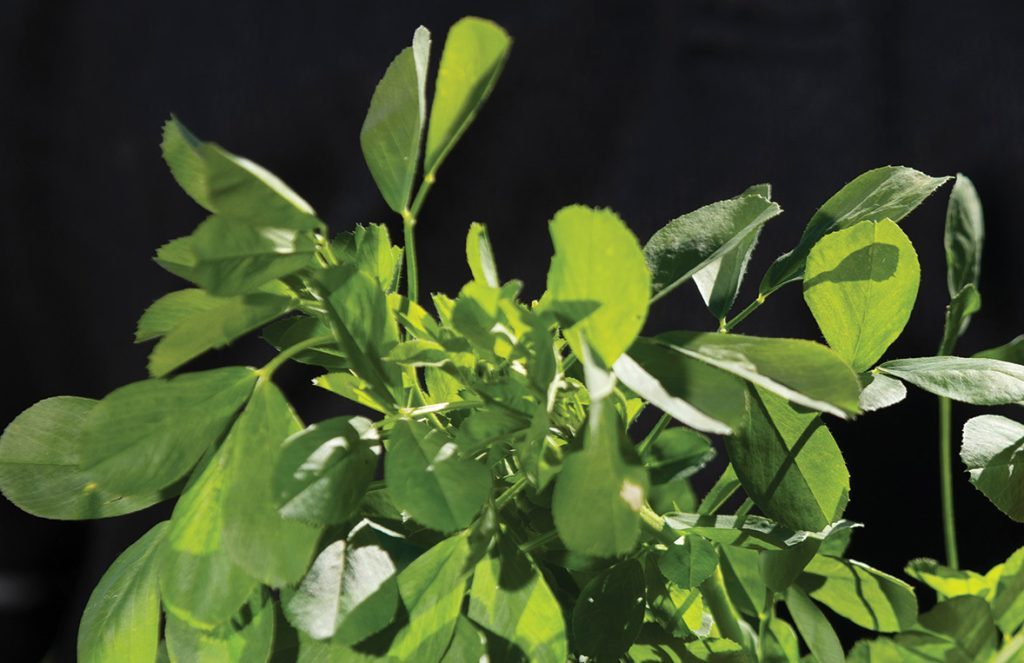
Who’s doing what with GM
What’s out there in the wide world of modern biotechnology?
If gene editing and other breeding tools get the political green light, farmers and growers can expect different plants and animals on offer down the track – but some way down the track.
Caradus is picking that, subject to sensible regulations, the first type of gene-editing we might see in NZ is SDN1 which doesn’t involve introducing new DNA. It can be as simple as making cuts to the target site and relying on the host cell to “fix up” the break by removing or changing the DNA bases. Or it might involve switching genes on and off with short-lived genetic signals.
“It has no foreign DNA, so takes away some concerns, and the technology is out there already,” Caradus said.
“It’s relatively unregulated in Canada and US for example, and in Australia you just need a legal statement to say it’s a SDN1 product.
“The first cab off the rank may be the gene-edited endophyte, developed by AgResearch and funded partly by Grasslanz and the Government.”
It protects the plant it lives on but doesn’t hurt the animal eating it. It’s done by “editing out” the grass staggers and heat stress effect in the fungus. Caradus said it could be commercialised within five years, or earlier, if the EPA accepts an application, adding that introduction would involve consultation with agriculture, public and iwi.
He said knowing exactly what’s out there globally is tricky as there’s no list of international genetically modified STM1 (suppressor technology) products that are available or being developed.
What is known is that across 26 countries there have been 824 approvals to date (2022) for cultivation of genetically modified (GM) crops. These include eight different GM traits, mostly for animal feeds. Between 70 and 90% of all GM crops, principally soybean and maize, are used to feed animals. The biggest users are USA, China and Europe – all major export markets for NZ. The product tastes the same. These traits do not change their composition or nutritional value for animals, Caradus said.
Grasses and forage species are behind. There are only a few examples of GM technologies being used commercially in grasses and forage species that could benefit New Zealand.
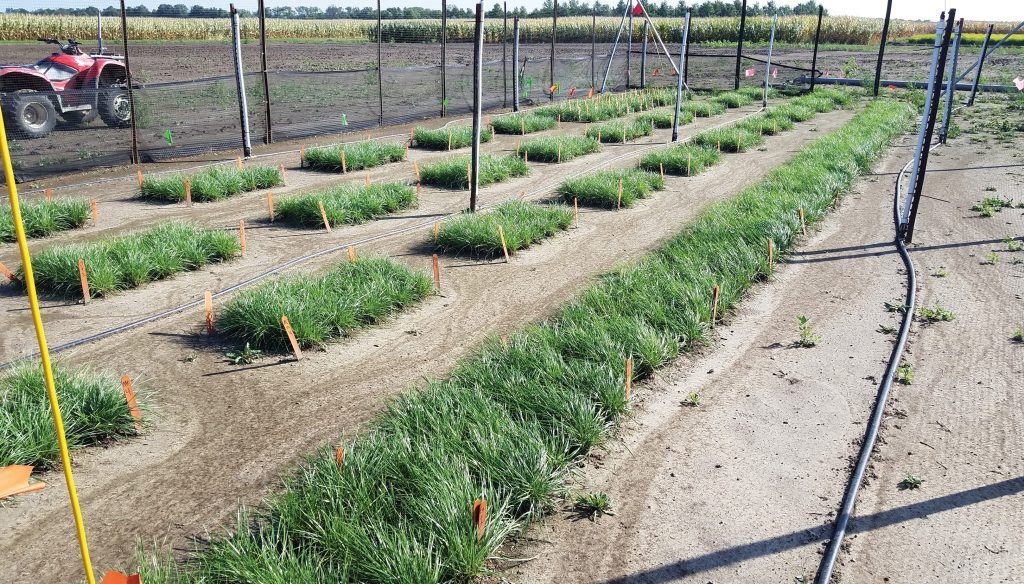
Australia has dipped a toe in while NZ sits on the deck. They have genetically modified (GM) canola, cotton and safflower crops approved for growing. They have developed a sorghum that is larger and has extra protein. This will grow beef or pork faster. It is also a food source for 500 million people who live in Sub-Saharan Africa. Research by the Queensland Alliance for Agriculture and Food Innovation has used gene-editing to lift sorghum protein from 9–10% to 15–16%. It has been grown in greenhouse conditions but will progress to outdoor field trials.
Wheat has been developed with increased yields, quality and tolerance to environmental stressors such as drought. The Commonwealth Scientific and Industrial Research Organisation (CSIRO) in Australia used a breeding technique called RNA interference (RNAi) to do this. RNAi switches genes on and off. It was also used to develop barley resistant to Yellow Dwarf Virus.
Monsanto (now owned by Bayer) is working on an RNAi spray to combat weeds that have developed resistance to its glyphosate herbicide. The spray would neutralise the resistance in those weeds. An interesting flip on the idea of genetically modified plants to withstand glyphosate.
NZ apiarists should be excited that RNAi could be used to target varroa mites in bees.
Farmers are right to get enthused about the potential. Current work includes a lucerne that doesn’t go starchy when harvest is delayed, potatoes that don’t go brown and a wheat that can withstand fungus infection.
CRISPR is one of the newest and most powerful of the gene-editing technologies. It’s cheaper, rapid and more accurate. It’s based on a natural bacterial immune system designed to defend cells against invaders by splitting up invasive DNA.
Japan has used CRISPR to develop three trials to date: fleshier red sea bream, high-growth tiger puffer fish and, to help lower blood pressure, a GABA-enriched tomato with five times as much of this amino acid. The tomato has more GABA by changing genes that normally limit GABA production.
Japan allows gene-edited products to be sold to consumers without safety evaluations as long as the techniques meet certain criteria. The US has adopted a similar screening process. Japan has used CRISPR to develop a rain-resistant wheat.
The Genetic Literacy Project website said that when the US Department of Agriculture allowed for deregulation of gene-edited plants in 2019, the agency approved more than 70 gene-edited plants. While the “boots ‘n’ all” approach occurred for plants, approval for animals has been slower. This is because the Food and Drug Administration (FDA), which oversees animal biotechnology in the US, takes a far more cautious approach.
Only one gene-edited animal has been approved in the US – the GalSafe Pig. This line of pigs, developed by Revivicor, has been gene-edited. An unwanted gene was “knocked out” to remove alpha-gal sugars from cell surfaces, reducing the risk of allergic reactions in people with Alpha-Gall Syndrome. It allows for wider use of pigs as food, as well as for organ transplants.
NZ scientists poised
Kiwi scientists are at the start gates, and in some cases commercial ventures are ready to take biotechnology-created products to trials, then market.
Drought-tolerant ryegrass and a grass that reduces methane emissions in animals that eat it are two AgResearch developments being trialled in the US, but excluded from NZ soil.
There may be a fair bit of “revving in neutral” for some time yet. It may take an election, a consultation period and a deep level of policy writing to get the green light.
AgResearch scientists are using genetic modification to select a high metabolisable energy (HME) ryegrass. This is funded by the Government and commercial partners Grasslanz Technology Ltd, PGG Wrightson Seeds and DairyNZ. This is being done by adding and modifying two plant genes to increase lipid content in the leaf and boost photosynthesis in the plant. Current research suggests that methane reductions of 10 to 15%may be achievable but animal feeding trials are still to be done. Work on the HME Ryegrass has taken place, in containment in NZ, and in outdoor growing trials in the US where the regulations allow it.
A second breeding programme is to capture the benefits of tannins in white clover. AgResearch scientists, working with seed companies, have identified a molecular “master switch” that accelerates the production of condensed tannins. This results in significant levels in the leaves of white clover. Condensed tannins reduce urinary nitrogen and methane production from grazing animals, reduce bloat, reduce internal parasite burden, and improve animal productivity. Research to date suggests methane reductions of 15% or more may be possible, but further research is needed. This includes animal feeding trials.

AgResearch has developed a ryegrass with a gene-edited endophyte, that produces a fungus to deter plant pests but doesn’t knock animal production and welfare. Ryegrass staggers and related heat issues can have huge effects on sheep, cattle and deer.
Malcolm Bailey from AgResearch’s Endophyte Gene Editing Steering Group said a change in out-dated regulations could see the trial work shifted back to NZ.
“The National Party policy is a welcome development.
“We are not asking for complete deregulation – we accept we need regulation.”
AgResearch has also developed a ryegrass that can withstand drought. A simple concept based on complex science that could have huge benefits for NZ farmers.
WHAT IS GENE SILENCING OR RNAI?
Gene silencing is a way of reducing, or switching off, the activity, or expression, of single genes. RNA is the courier that delivers the gene’s instructions to make a protein. By changing the instructions for the RNA, a gene can be prevented from making its protein – therefore “silencing” the gene.
Good RNA is single stranded, bad RNA from viruses tends to be double-stranded.
By introducing a complimentary strand that will bind to the RNA, they make it double stranded which is alarming to the host.
Gene silencing is also referred to as RNA interference (RNAi). RNA interference is a naturally occurring mechanism that has evolved in plants and animals over millions of years as a defence against viruses. Scientists from Australia’s national science agency CSIRO won an international award in 2007 for their discovery of how to silence genes in plants.
GENE MODIFICATION
AgResearch is at the start gate with gene edited fungus and plants.
- White clover with higher condensed tannins (less bloat, better resistance parasites, improved animal production, lower methane 15%+)
- Drought-tolerant ryegrass (currently trialled in US)
- Hypoallergenic milk
- Low emission ryegrass to reduce methane 10-15% (currently trialled in US)
- Endophyte that deters plant pests but is easy on the animal grazing it.


